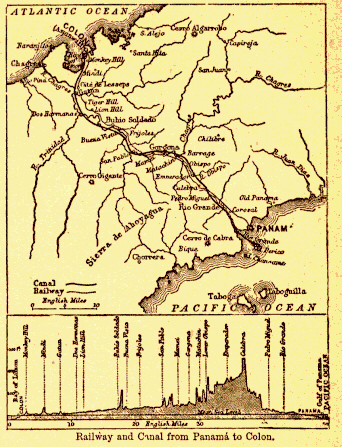The Panama Railroad
Today, we build the first transcontinental railroad. The University of Houston's College of Engineering presents this series about the machines that make our civilization run, and the people whose ingenuity created them.
We all know how a golden spike, driven in northern Utah in 1869, finally let us travel by rail from Atlantic to Pacific. But did you know that the first transcontinental railroad was finished fifteen years earlier, in 1854, and not in the United States?
It began with three speculators in New York in the late 1840s. They were financier Henry Chauncey, merchant William Henry Aspinwall, and John Lloyd Stephens who needs some explaining. Historian David McCullough calls Stephens a diplomat, lawyer, raconteur, amateur archaeologist, and writer of travelogues.
The three decided it'd be profitable to create a proper trade route to the Mexican province of California. Aspinwall already held a government franchise to deliver mail to California. Now the trick was to carry people and heavier goods. But America's west was hardly charted, and covered-wagon traffic had hardly begun. Not even Pony Express service would be running before 1860. For now most trade with California had to cross the Isthmus of Panama.
Typically, a combination steam and sailing ship would leave New York and make the 2000-mile journey to Panama. The overland trip through terrible mosquito infested jungles from Atlantic to Pacific was only 47 miles, but it took the better part of a week. Then another ship made the 3500-mile trip to San Francisco. That 47-mile leg was a huge impediment, and these businessmen set out to replace it with a rail link.
It was Stephens who became on-site president of the railroad company. He dove into Panama's jungles, driving the initial work while it still seemed impossible. Then, in 1852, he died of cholera. That same year, Ulysses S. Grant crossed the Isthmus with several hundred soldiers headed for California. He lost 250 people. As an old man, he talked more about the horrors of Panama than the horrors of the Civil War. When the railroad was finished in 1855, it'd cost eight million dollars and an estimated 6000 lives. It cost more than any stretch of railroad we've ever made.
So many workers died of cholera, malaria, and worse, that body disposal became a problem. The company finally began pickling the dead in barrels and selling them to medical schools. They used the proceeds to fund a hospital.
Thirty years later the French lost 20,000 lives in an abortive attempt to dig a Panama Canal, and they almost bankrupted France. America didn't finish the Canal until 1914. All the while this visionary railroad tied one ocean to the other. It was immensely profitable from the day it opened and it staked out the route for the canal that would, in a far future, completely change the game.
Today we talk about the Golden Spike and forget our first transcontinental railroad -- which, on the eve of the Civil War, many people called America's greatest engineering feat.
I'm John Lienhard, at the University of Houston, where we're interested in the way inventive minds work.
(Theme music)
McCullough, D., Brave Companions: Portraits in History. New York: Simon & Schuster, 1992, Chapter 6.
Otis, F. N., Illustrated History of the Panama Railroad. New York: Harper & Brothers, Publishers, 1862.

Route of the Panama Railroad
(From the Encyclopedia Britannica, 1897)